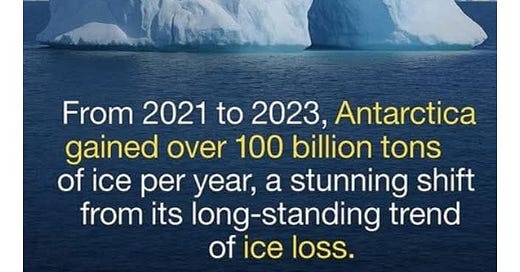Can You Believe It? Antarctic Ice Mass Increases by 100 Billion Tons, Driven by Anomalous Snowfall
Antarctic Ice Gain Documented, Framed as Anomaly by Lamestream Media
Recent satellite measurements analysed by researchers at Tongji University, using NASA instrumentation, show that Antarctica gained over 100 billion tons of ice in a single year. The increase was attributed to higher-than-normal snowfall driven by anomalous precipitation patterns. Scientists involved in the analysis apparently claimed the gain as temporary and not indicative of a long-term reversal, but confirmed the data’s accuracy.
This stands in contrast to longstanding messaging about consistent ice loss in Antarctica driven by climate change. Despite the magnitude of the ice increase, it has received minimal media attention and is being described by many outlets as a short-term anomaly. Researchers emphasise the trend remains downward overall, but the significant annual gain is a documented fact.
Historical context shows similar shifts in climate narratives. In the 1970s, leading publications including Time, Newsweek, and the New York Times featured reports warning of global cooling and a potential new ice age. These reports were supported by then-current data on declining temperatures, atmospheric conditions, and ecological indicators. At the time, the tone in media and scientific communication reflected high confidence. These forecasts did not materialize.
The messaging later shifted toward global warming, with similar language of urgency and consensus. Retrospective portrayals now often describe the global cooling warnings as fringe or overblown, despite their widespread publication. The structure of current climate communication, with its emphasis on consensus and finality, mirrors that earlier period.
The core issue is not the scientific process, but how scientific findings are selectively highlighted or dismissed by institutions and media. The ice gain in Antarctica is a significant data point. The absence of substantial re-evaluation or public reflection following this report suggests a narrow framing of climate discourse. Contradictory evidence is being downplayed instead of being integrated.
Scientific credibility requires openness to self-correction and critical scrutiny, not selective emphasis. They just pick and choose that which fits their narrative. The Antarctic ice gain, while possibly temporary as they claim ( I doubt it), warrants examination without immediate minimisation and downplaying.
For historical records let us leave a chronological list of lies of major climate-related claims and narratives from the mid-20th century to today. We will just add the new scam as it appears:
Global Cooling Scare (1960s–1970s)
Ozone Layer Depletion Crisis (1980s–1990s)
Global Warming Catastrophe Predictions (Late 1980s–1990s)
Sea Level Rise Wiping Out Nations by 2000
Arctic Ice-Free Summers Predicted (2000s–2010s)
Polar Bear Extinction Warnings
“12 Years to Save the Planet” (2018)
Climate Lockdowns and COVID Comparisons
Carbon Credit and Offset Market Scams
ESG “Green” Investing Frameworks
Every Weather Event Attributed to Climate Change
Use of “Settled Science” to Shut Down Debate
Media Overstatement of IPCC Report Conclusions
Manipulated Climate Models and Data Adjustments
Rebranding of Fossil Fuel Firms as Green
UN and NGO Climate Doomsday Timelines
Suppression and Censorship of Scientific Dissent
Failed Climate Predictions by Public Figures
Overstated Melting in Antarctica and Greenland
Use of Children (e.g., Greta Thunberg) for Climate Messaging
All my analyses or reports are free to read, thanks to the generosity of my readers. Independent journalism nonetheless requires investment, so if you value this article or any others, please consider sharing, or even becoming a paid subscriber. Your support is always gratefully received, and will never be forgotten. To buy me a coffee or two, please click this link.
buymeacoffee.com/ggtv




